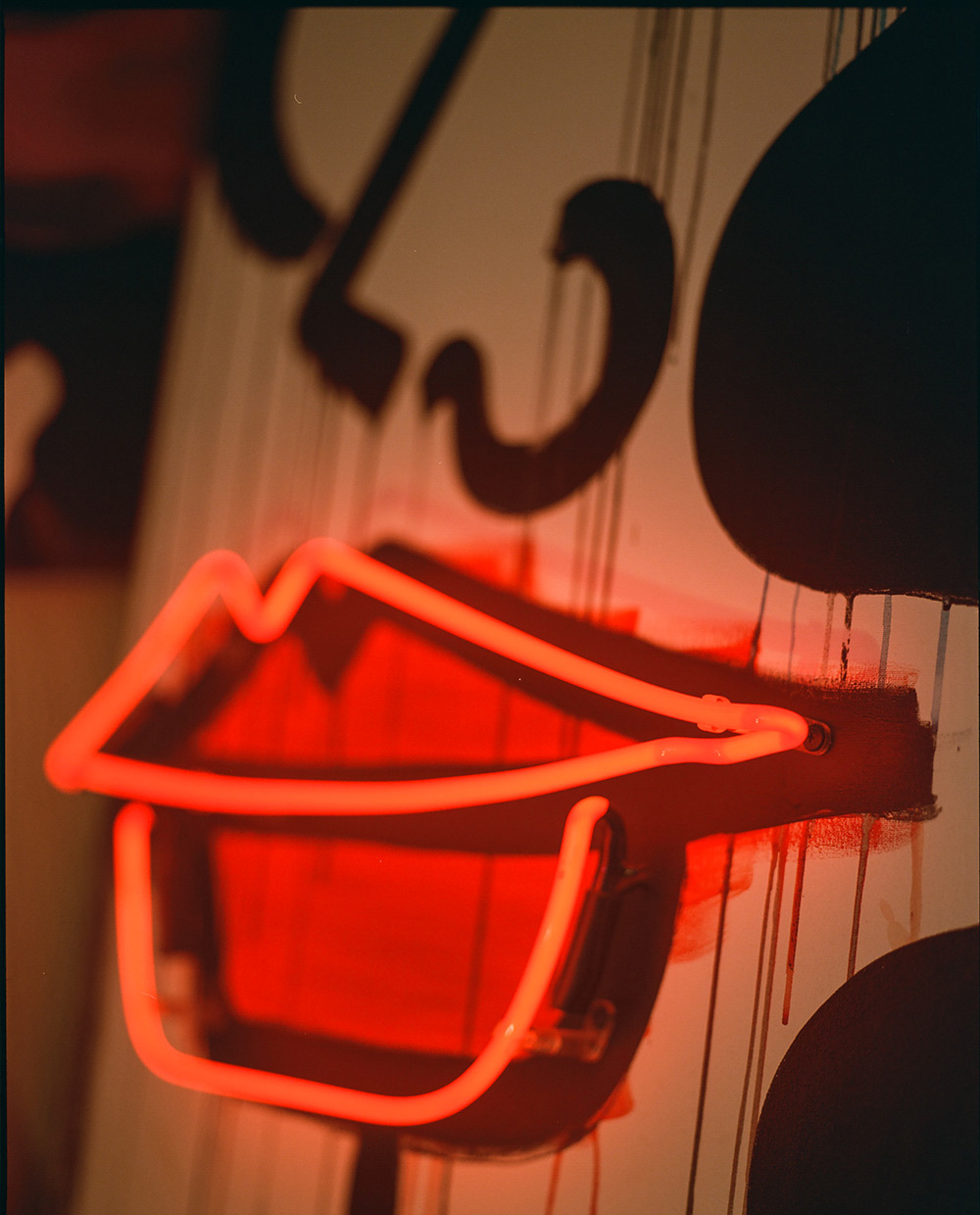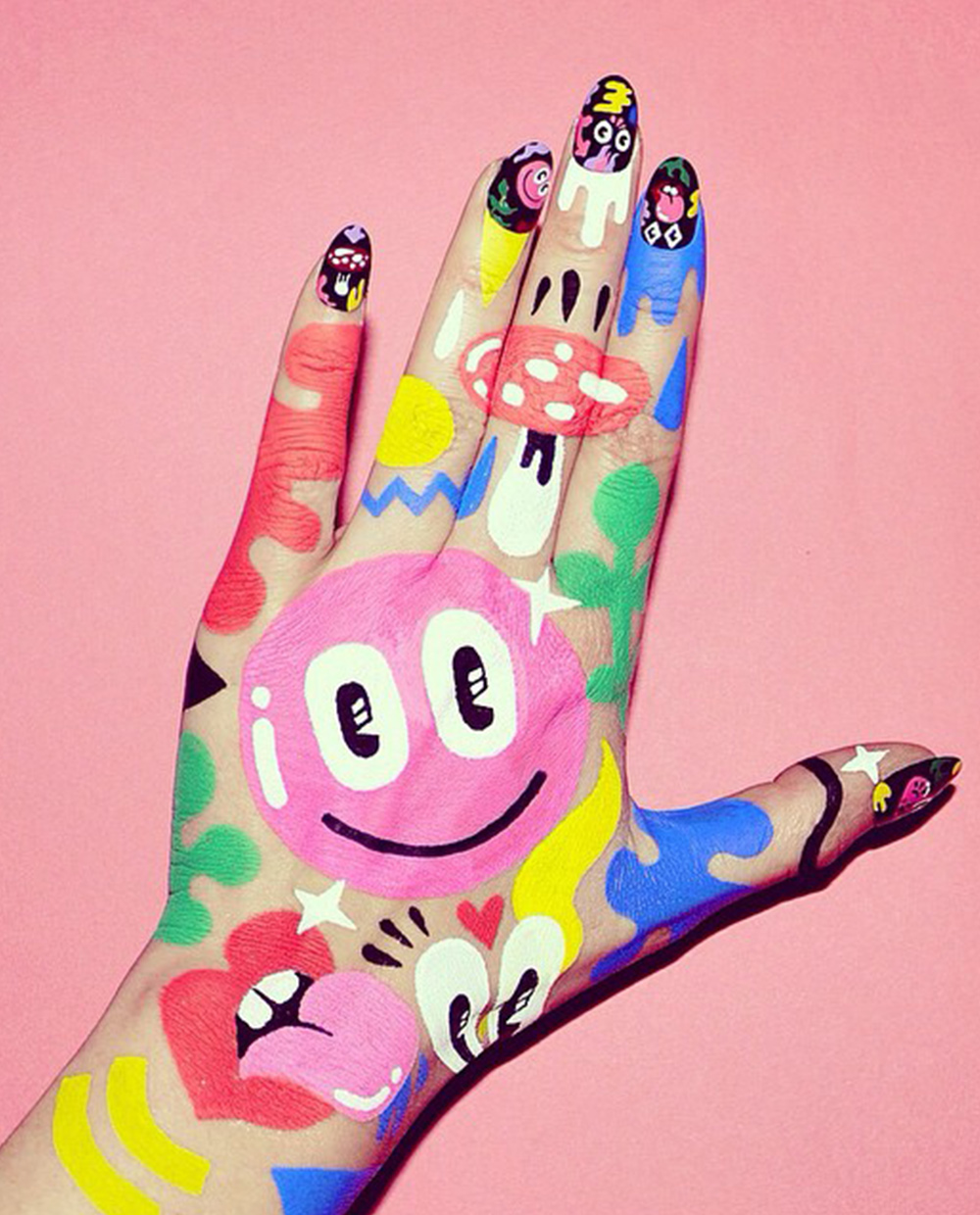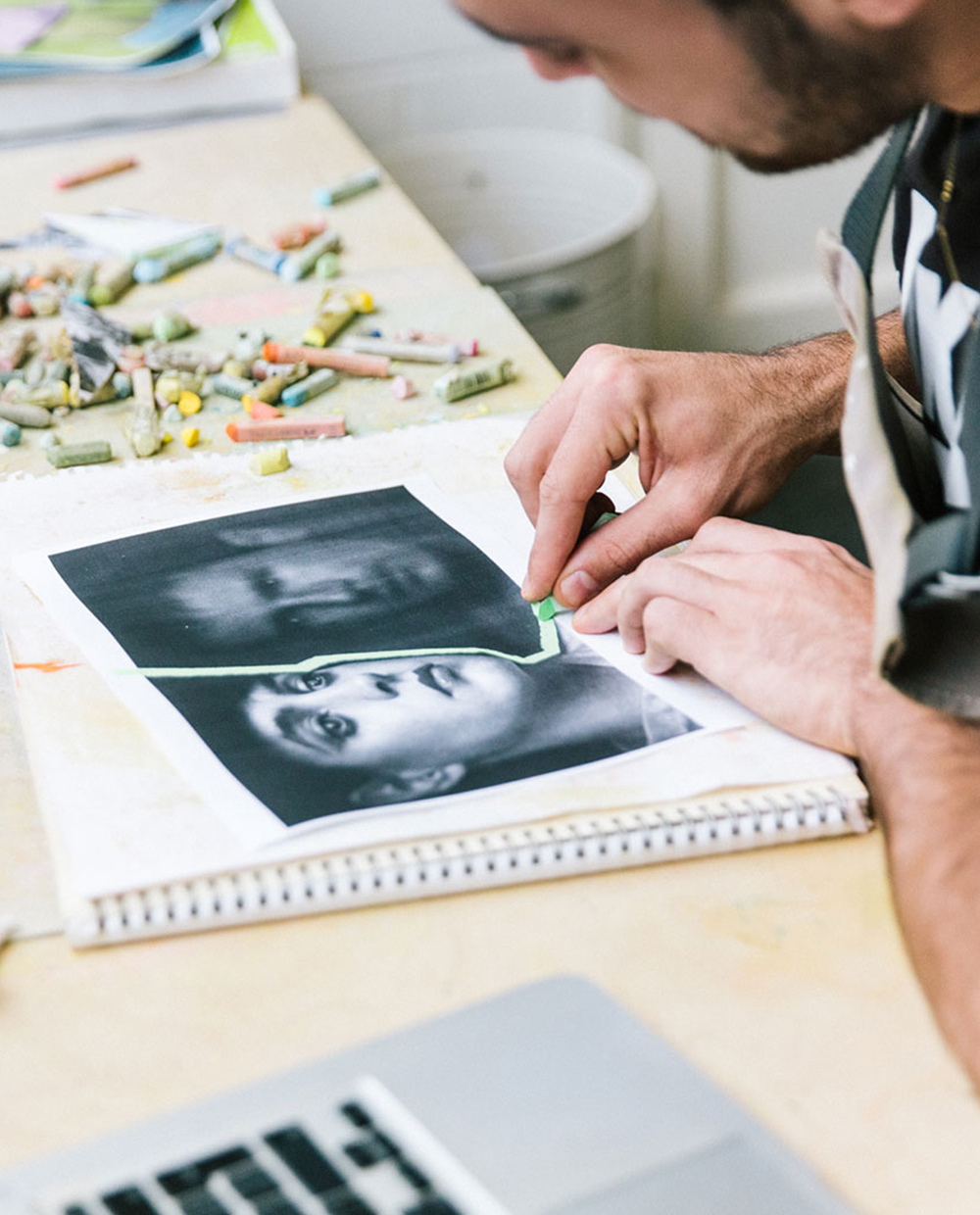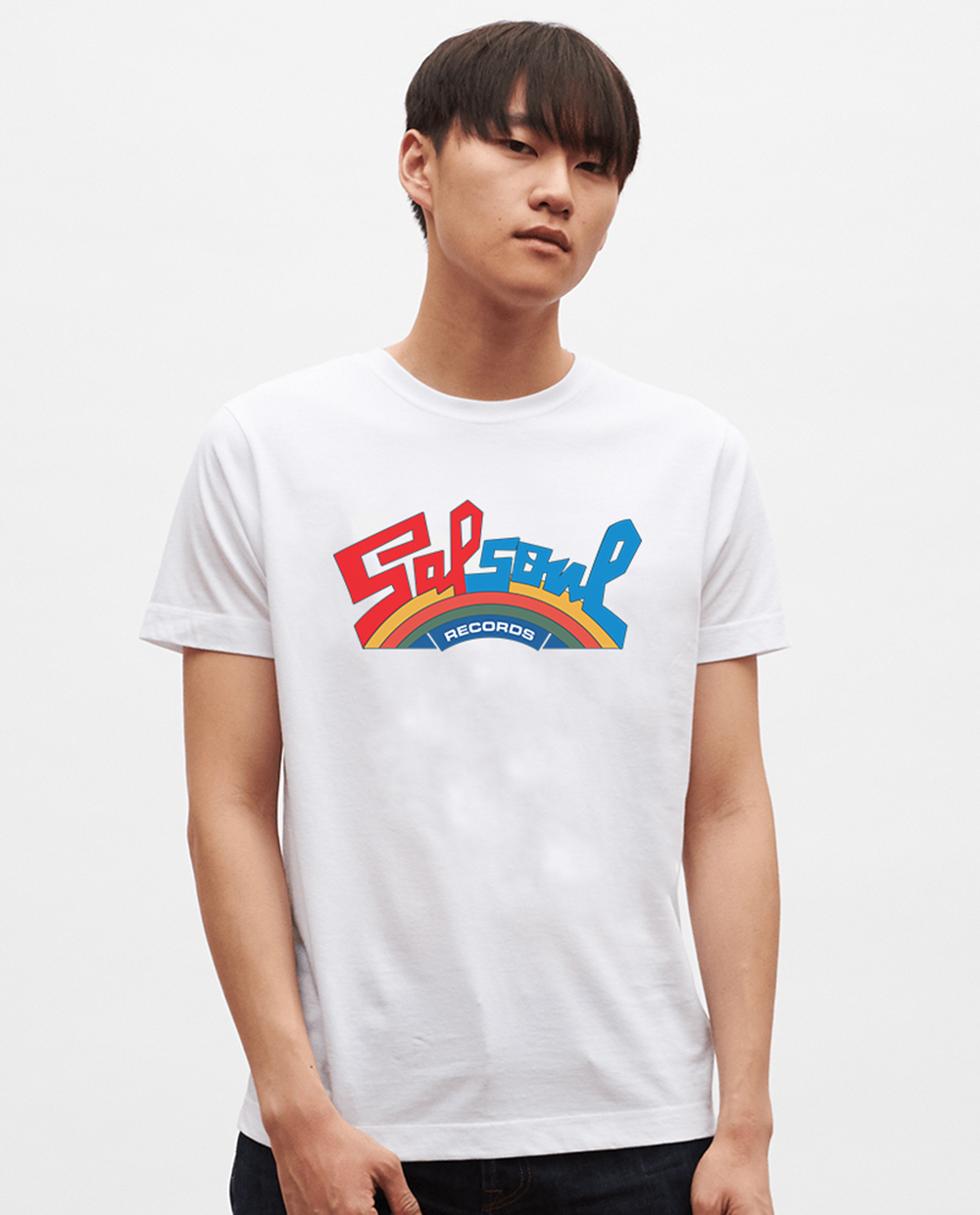It’s a cold and wintry afternoon in Finsbury Park but Anna’s studio is basking in a golden glow. She sits at a desk in the corner, wearing a slouchy red hoodie with matching red boots and paint splattered jeans. Her air of nonchalance has a certain electricity that embodies the same sort of intrigue as her art, which is further accentuated by studio walls plastered with postcards, off-the-cuff drawings on Balthazar placemats, a random selection of scrawlings, and her seldom-found extra-fat Sharpies. Anna’s studio has a certain feeling of curated chaos, and it all makes total sense. After polishing off a shot of moka-made espresso, we decide to dive a little deeper in the world of Anna and the enigmatic “face”.
Tell us a little more about yourself – what’s your backstory?
I’m a visual artist from Milan. I’ve been painting for quite some time, a few decades, but four years ago I started to do street art, mainly out of curiosity, and to challenge myself. It was really thrilling so I just got hooked, painting every single hoarding I could find on my way.
What are the main differences between the art scenes of Milan and London?
I first moved to London over 15 years ago. I was here for maybe one or two years and then moved to the States. I was going back and forth between London and New York for many years but eventually realised it was too much of an effort to get a visa, so I moved here permanently, as I prefer London. I’ve found my comfort zone and I’m feeling at one.

Do you think London is a good place for creatives?
I can only talk from experience but I believe London is a good place for creatives as there’s more opportunity to have a voice. I’m quite settled and have established a network here, so it works well for me. I don’t buy the Berlin thing, or even New York; they’re very corporate and focused on money making. The myth of New York is kind of faded but I feel there are still pockets of opportunity in London.
What was the catalyst behind moving your art from the studio to the street?
I was spending a lot of time in Shoreditch with friends, and of course, it’s a playground for street art and graffiti. A lot of art was the same or by the same artist and my friend started encouraging me to join in. I thought maybe I was too old but decided to give it a go regardless, and haven’t stopped since.
Were you based in the studio before that, doing the same sort of work?
Yeah, pretty much. My work hasn’t changed but it has been steadily developing. The subject and the motif of the lady has been consistent – sometimes it changes with various colours and textures, but the style always remains the same.
Where did the face come from? Is it based on a person or figure?
It is more of an attitude, a personality, or a character in general, rather than a particular person. It’s a state of mind and a way of being. People might recognise their girlfriend, their mother, or their sister in her and I like that. I don’t want to name it because then she would become too fixed, so it’s just “the face” to me.

How did you find the transition from the studio to the street? I know of people who have done stretches in prison for graffiti and street art. How does that risk make you feel?
I was put in prison for my art recently in New York. I was arrested and it made me feel really vulnerable – I have never felt so frightened. It put me off going back there, not because I’m not allowed, but because of the way I was treated. I wasn’t even doing graffiti either, it was a paste-up on a lamppost. It was still wet so I could have peeled it off, no big deal, but they were so aggressive. I felt very humiliated and realised that I don’t want to go through that again. It’s not my thing.I’m going through a phase where I’m rejecting everything about New York. The police all have guns and they are trained to treat you as a criminal when they catch you, regardless of the crime.
I’m going through a phase where I’m rejecting everything about New York. The police all have guns and they are trained to treat you as a criminal when they catch you, regardless of the crime.
All the artists I know in New York said I had been so lucky with my street art, as I’ve been doing paste-ups for years and never been caught. I’ve got my strategy, and do my work during the day in front of everybody, and also maybe it helps that I’m a woman. With the New York incident, they could have just stopped me and I would have justified my actions. I thought I would be able to chat my way out of it but there’s no chance as they don’t let you talk. They handcuffed me and put me in a car. You’re supposed to take off all of your jewellry before they put you in the cell, but I was shaking so much that I couldn’t. I pointed at a policewoman in the group and asked if she could help me but the arresting officer told me not to call her a lady, but an officer. That’s the level of people there.
My friend was caught doing stickers in New York and got put in jail for almost 24 hours. It’s ridiculous, but I guess it relates to the American system and the way the people are behaving right now.

Before getting caught, is there a bit of a rush?
Indeed, it’s part of the game and feels good when you get away with it – the risk becomes part of the thrill, but you never expect that level of treatment. Even in Europe, I’m doing street art more consciously now, as I don’t want to be in that situation ever again. To me, putting my work on buildings was fun and something different than being alone in my studio. The street is a great way to promote your work, as my profile is being subjected to anyone that walks by, and not confined to certain people that go to certain galleries. It’s a very powerful tool.
If you’re working with street art are you more likely to go out and work at night?
I work during the daytime, but recently I’ve changed my strategy because people are recognising the face. It generates a crowd, which in turn means more chance of getting caught. I’m actually doing less and less on the street than I was in the beginning, as I’m getting more private work. I don’t want to overdo it either; I got really carried away at the start because it was a lot of fun. I still love street art but I’m not like I used to be – spending most of my afternoons looking for blank hoardings like a mad woman. I was really addicted!

I saw your Grenfell piece in central London. Would you like to push more of a political agenda within your work?
I really felt for the Grenfell victims as I used to live in that area. The duty of an artist is to be aware of what’s going on in society, but for me, art should also be a message of beauty and something people can appreciate. That’s the sort of message I want to portray with my art.
Your art is a very positive expression then, like some of the text and phrases that you use?
I collect a lot of quotes picked up from philosophers or poets and often write them next to a piece if I want to add more depth. I really like the work of Seneca – it’s from Ancient Rome, so very antique in terms of timing, but it’s very empowering and touches on subjects such as intuition.
Where would you like to take your work in the next few years?
I’m going back to Tokyo next year and plan on spreading my wings a bit more. I want to carry on painting in my studio and maybe get a bigger place eventually, then the ultimate goal is to open my own gallery in central London.







